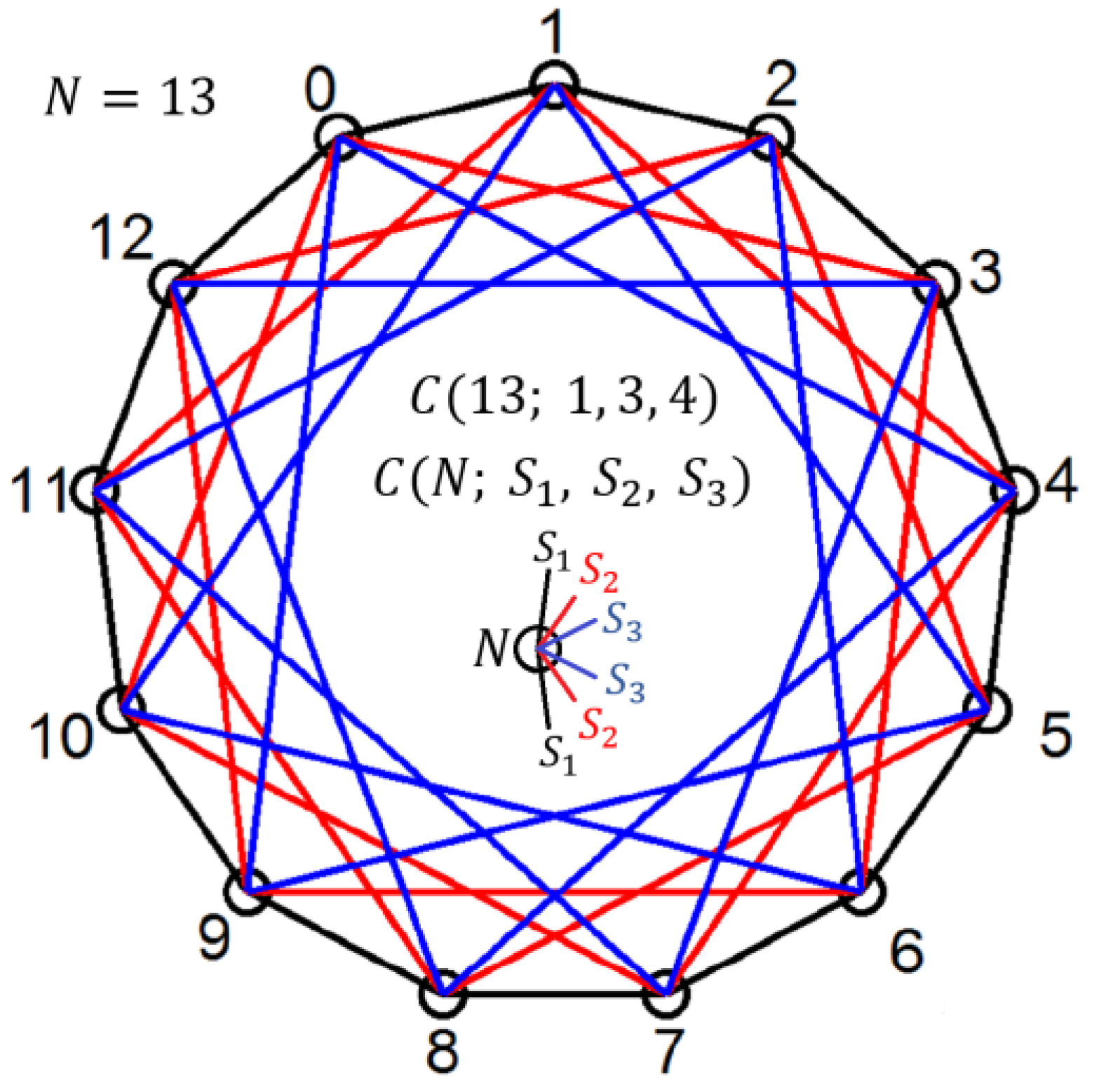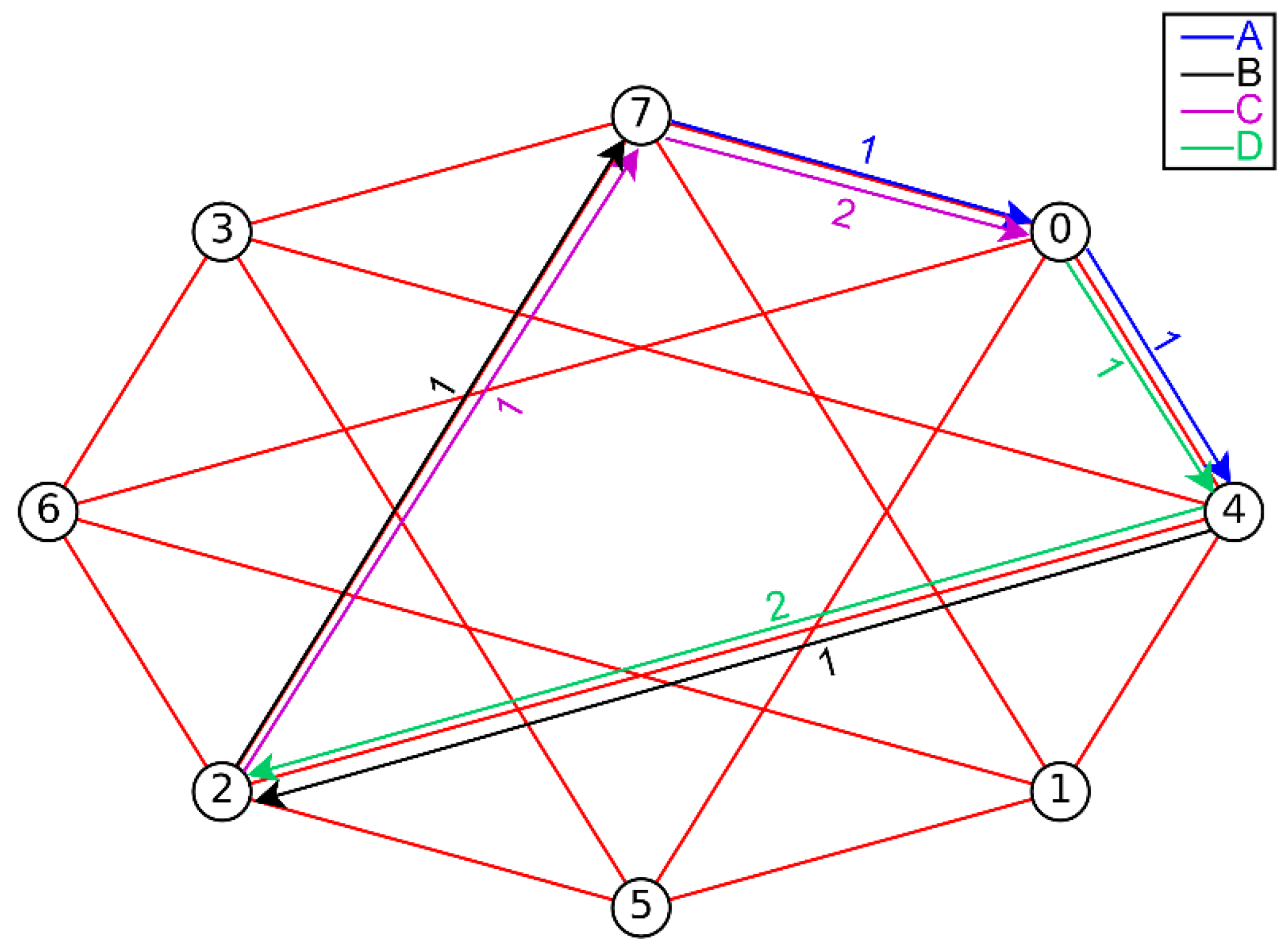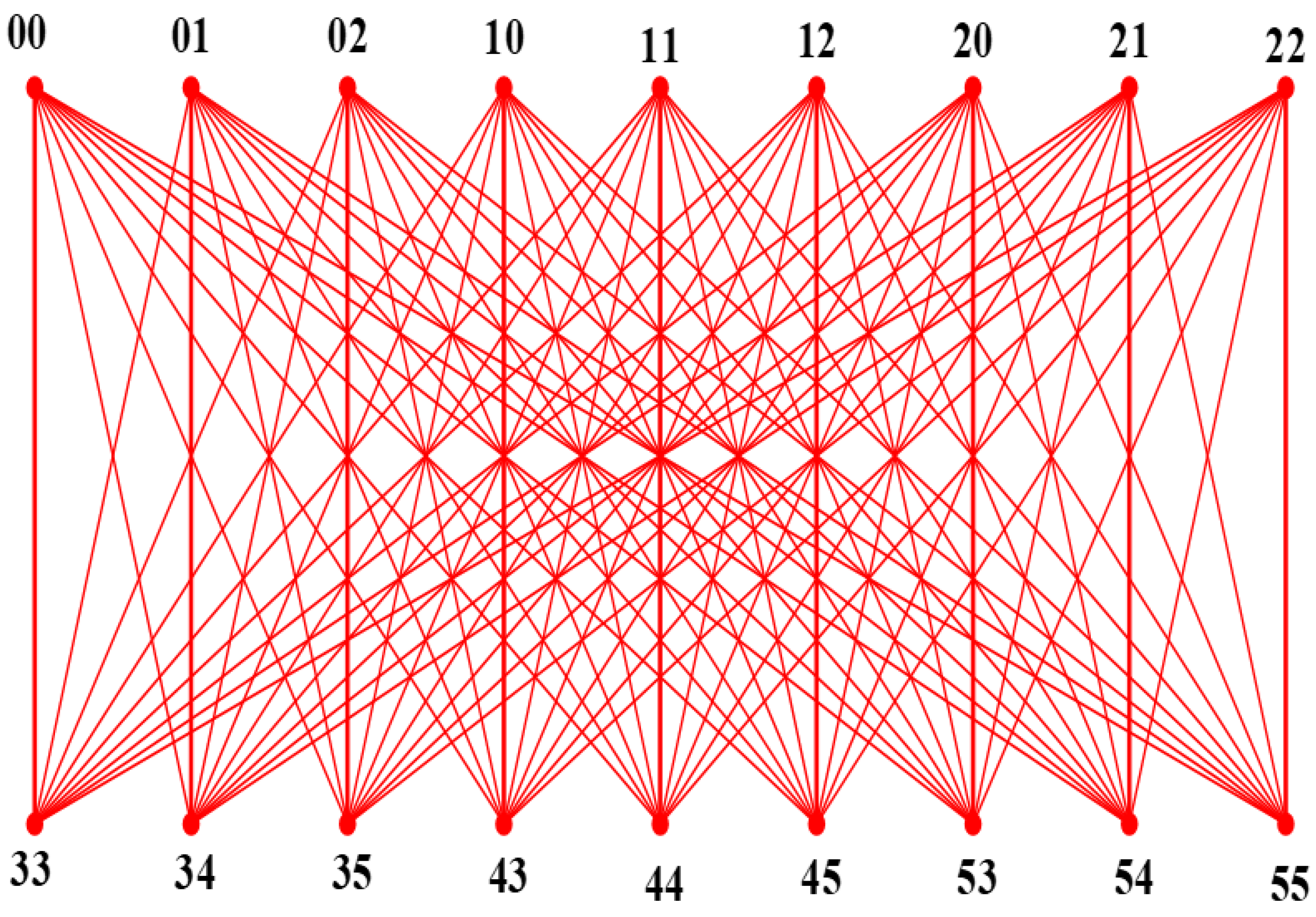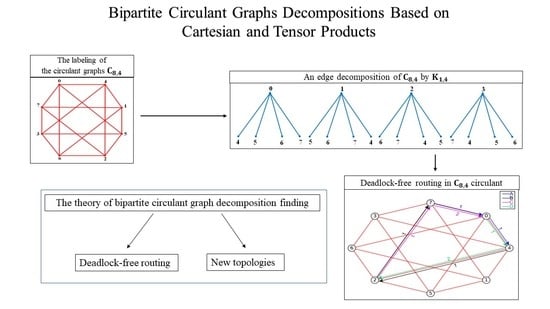3. Edge Decomposition of Bipartite Circulant Graphs Based on Cartesian Products
In this section, if graph is represented by the vector and graph is represented by the vector then , where and The edge set of graph can be constructed based on , as shown in the following proposition.
Proposition 1.
If there is an edge decomposition ofby the graphand an edge decomposition ofby the graphthen there is an edge decomposition ofby the graph
Proof. Let . Make the following an ordered pair chain: where the following condition
is satisfied, and the difference between
and
is calculated modulo
Let
Make the following an ordered pair chain:
where the following condition
is satisfied, and the difference between
and
is calculated modulo
. The edge set of the first graph
can be represented by
and the edge set of the second graph
can be represented by
.
Suppose that the first graph
is represented by the vector
, and the second graph
is represented by the vector
, then
, where
and
Then, construct the ordered pairs
, where
and
Hence, from (1) and (2), we can conclude that
Then, let
be a one–one mapping defined by
and
be a one-one mapping defined by
Hence, we can obtain the following chain
The translation for the previous chain is
where the additions are calculated modulo
Let
; it is a one–one mapping defined by
We now find novel chains of ordered pairs that are defined by . These novel chains represent the edge decomposition of i.e., and that can be proved as follows. Let , which is unique for every pair . For , let and . Suppose that such that there is at least one edge . From the translation definition, we have , and is unique for every edge in Hence, . Then, the addition of to the second component of the ordered pairs constructs the edge decomposition of Hence, . □
Theorem 1.
There is an edge decomposition ofby the graphand an edge decomposition ofby the graph, then there is an edge decomposition ofby the graph.
Proof. The edge set of can be represented by where
Hence, .
The edge set of the second graph
can be represented by
, where
Hence, .
Suppose that the first graph
is represented by the vector
, and the second graph
is represented by the vector
, then
, where
and
. Then, construct the ordered pairs
where
and
. Hence, from (7) and (8), we can conclude that
Then, let
be a one–one mapping defined by
and
be a one–one mapping defined by
Hence, we can obtain the following chain
. The translation for the previous chain is
, where the additions are calculated modulo
. Let
; it is a one-one mapping defined by
We now find novel chains of ordered pairs that are defined by . These novel chains represent the edge decomposition of i.e., , and that can be proved as follows. Let , which is unique for every pair . For , let and . Suppose that such that there is at least one edge . From the translation definition, we have ; is unique for every edge in Hence, . Then, the addition of to the second component of the ordered pairs constructs the edge decomposition of Hence, . □
Lemma 1.
There is an edge decomposition ofby the graphand an edge decomposition ofby the graphthen there is an edge decomposition ofby the graph.
Proof. The edge set of can be represented by , where
Hence, .
The edge set of the second graph
can be represented by
, where
Hence, .
Suppose that the first graph
is represented by the vector
, and the second graph
is represented by the vector
, then
, where
and
. Then, construct the ordered pairs
where
and
. Hence, from (13) and (14), we can conclude that
Then, let
be a one–one mapping defined by
and
be a one–one mapping defined by
Hence, we can obtain the following chain
. The translation for the previous chain is
, where the additions are calculated modulo
. Let
be a one–one mapping defined by
We now find novel chains of ordered pairs that are defined by . These novel chains represent the edge decomposition of i.e., and that can be proved as follows. Let , which is unique for every pair . For , let and . Suppose that such that there is at least one edge . From the translation definition, we have ; is unique for every edge in Hence, . Then, the addition of to the second component of the ordered pairs constructs the edge decomposition of . Hence, . □
Lemma 2.
There is an edge decomposition ofby the graphand an edge decomposition ofby the graph, then there is an edge decomposition ofby the graph.
Proof. The edge set of can be represented by , where
Hence, .
The edge set of the second graph
can be represented by
, where
Hence, .
Suppose that the first graph
is represented by the vector
, and the second graph
is represented by the vector
, then
, where
and
. Then, construct the ordered pairs
where
and
. Hence, from (19) and (20), we can conclude that
Then, let
be a one–one mapping defined by
and
be a one–one mapping defined by
Hence, we can obtain the following chain
. The translation for the previous chain is
, where the additions are calculated modulo
. Let
; it is a one–one mapping defined by
We now find novel chains of ordered pairs that are defined by . These novel chains represent the edge decomposition of i.e., and that can be proved as follows. Let , which is unique for every pair . For , let and . Suppose that such that there is at least one edge . From the translation definition, we have is unique for every edge in . Hence, . Then, the addition of to the second component of the ordered pairs constructs the edge decomposition of . Hence, . □
Theorem 2.
There is an edge decomposition ofby the graphand an edge decomposition ofby the graph, then there is an edge decomposition of by the graph.
Proof. The edge set of can be represented by , where
Hence, .
The edge set of the second graph
can be represented by
where
Hence, .
Suppose that the first graph
is represented by the vector
, and the second graph
is represented by the
, then
, where
and
. Then, construct the ordered pairs
where
and
. Hence, from (25) and (26), we can conclude that
Then, let
be a one–one mapping defined by
and
be a one–one mapping defined by
Hence, we can obtain the following chain
. The translation for the previous chain is
, where the additions are calculated modulo
Let
be a one–one mapping defined by
We now find novel chains of ordered pairs that are defined by . These novel chains represent the edge decomposition of i.e., and that can be proved as follows. Let , which is unique for every pair . For , let and . Suppose that such that there is at least one edge From the translation definition, we have , and is unique for every edge in Hence, . Then, the addition of to the second component of the ordered pairs constructs the edge decomposition of . Hence, . □
Theorem 3.
There is an edge decomposition ofby the graphand an edge decomposition ofby the graphthen there is an edge decomposition ofby the graph.
Proof. The edge set of can be represented by , where
Hence, .
The edge set of the second graph
can be represented by
, where
Hence, .
Suppose that the first graph
is represented by the vector
, and the second graph
is represented by the vector
, then
, where
and
. Then, construct the ordered pairs
, where
and
. Hence, from (31) and (32), we can conclude that
Then, let
be a one–one mapping defined by
and
be a one–one mapping defined by
Hence, we can obtain the following chain
. The translation for the previous chain is
, where the additions are calculated modulo
. Let
be a one–one mapping defined by
We now find novel chains of ordered pairs that are defined by . These novel chains represent the edge decomposition of i.e., and that can be proved as follows. Let , which is unique for every pair . For , let and . Suppose that such that there is at least one edge . From the translation definition, we have ; is unique for every edge in Hence, . Then, the addition of to the second component of the ordered pairs constructs the edge decomposition of . Hence, . □
Theorem 4.
There is an edge decomposition ofby the graphand an edge decomposition ofby the graph, then there is an edge decomposition ofby the graph.
Proof. The edge set of can be represented by , where
Hence, .
The edge set of the second graph
can be represented by
, where
Hence, .
Suppose that the first graph
is represented by the vector
, and the second graph
is represented by the vector
, then
where
and
. Then, construct the ordered pairs
, where
and
. Hence, from (37) and (38), we can conclude that
Then, let
be a one–one mapping defined by
and
be a one–one mapping defined by
Hence, we can obtain the following chain
. The translation for the previous chain is
, where the additions are calculated modulo
. Let
; it is a one-one mapping defined by
We now find novel chains of ordered pairs that are defined by . These novel chains represent the edge decomposition of i.e., and that can be proved as follows. Let , which is unique for every pair . For , let and . Suppose that such that there is at least one edge . From the translation definition, we have ; is unique for every edge in Hence, . Then, the addition of to the second component of the ordered pairs constructs the edge decomposition of Hence, . □
Theorem 5.
There is an edge decomposition ofby the graphand an edge decomposition ofby the graph, then there is an edge decomposition ofby the graph.
Proof. The edge set of can be represented by , where
Hence, .
The edge set of the second graph
can be represented by
where
Hence, .
Suppose that the first graph
is represented by the vector
, and the second graph
is represented by the vector
then
, where
and
. Then, construct the ordered pairs
where
and
. Hence, from (43) and (44), we can conclude that
Then, let
be a one–one mapping defined by
and
be a one–one mapping defined by
Hence, we can obtain the following chain
. The translation for the previous chain is
, where the additions are calculated modulo
Let
be a one–one mapping defined by
We now find novel chains of ordered pairs that are defined by . These novel chains represent the edge decomposition of i.e., and that can be proved as follows. Let , which is unique for every pair . For , let and . Suppose that such that there is at least one edge . From the translation definition, we have ; is unique for every edge in Hence, . Then, the addition of to the second component of the ordered pairs constructs the edge decomposition of . Hence, . □
Finally, as we stated in Proposition 1, if there is an edge decomposition of
by graph
and an edge decomposition of
by graph
then there is an edge decomposition of
by graph
Hence, we can show the classes of graph
, graph
and graph
to summarize the constructed results in
Section 3.
Table 1 exhibits these results.
Example 1.
The labeling of the circulant graphsandis exhibited in Figure 2. Figure 3 shows an edge decomposition ofbyIn addition, an edge decomposition ofby,
based on the Cartesian product, is exhibited in Figure 4.
We provide the general tensor product method for constructing the decomposition of the circulant graphs in the section that follows.
















